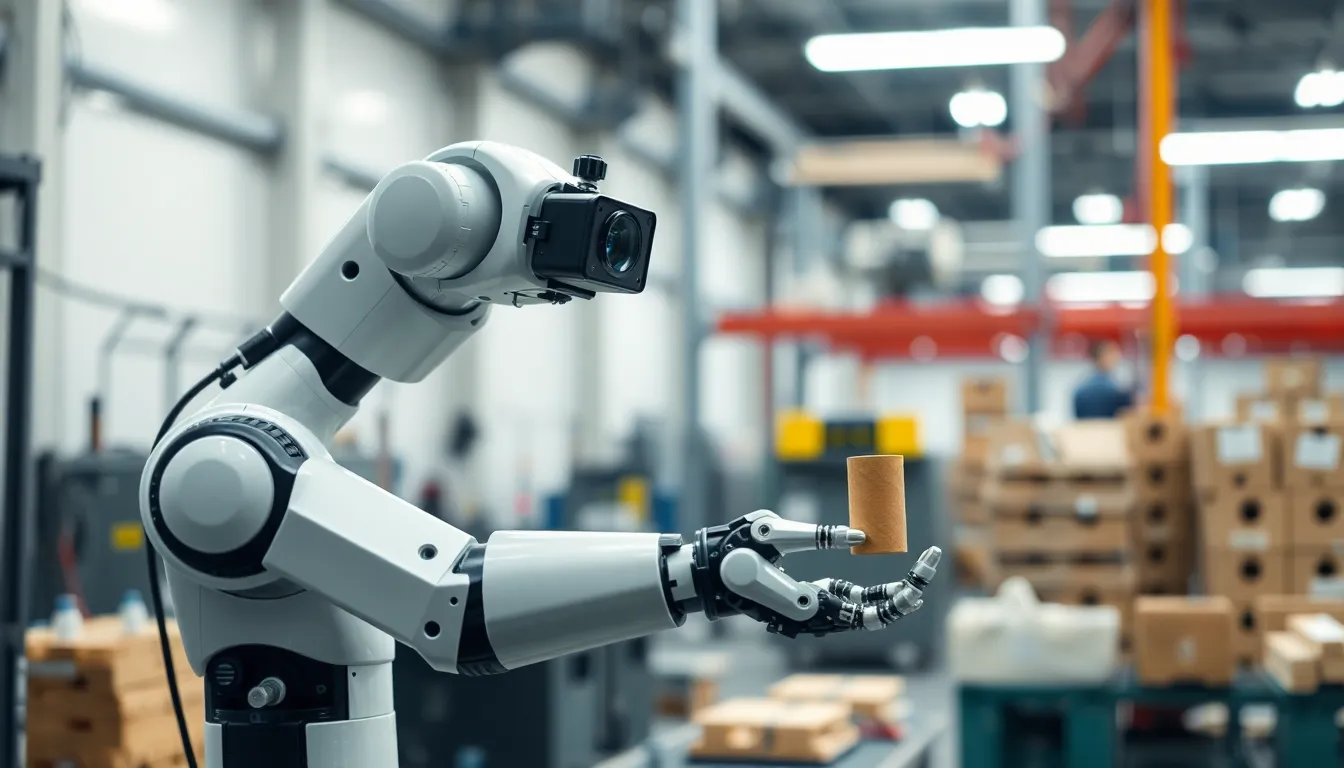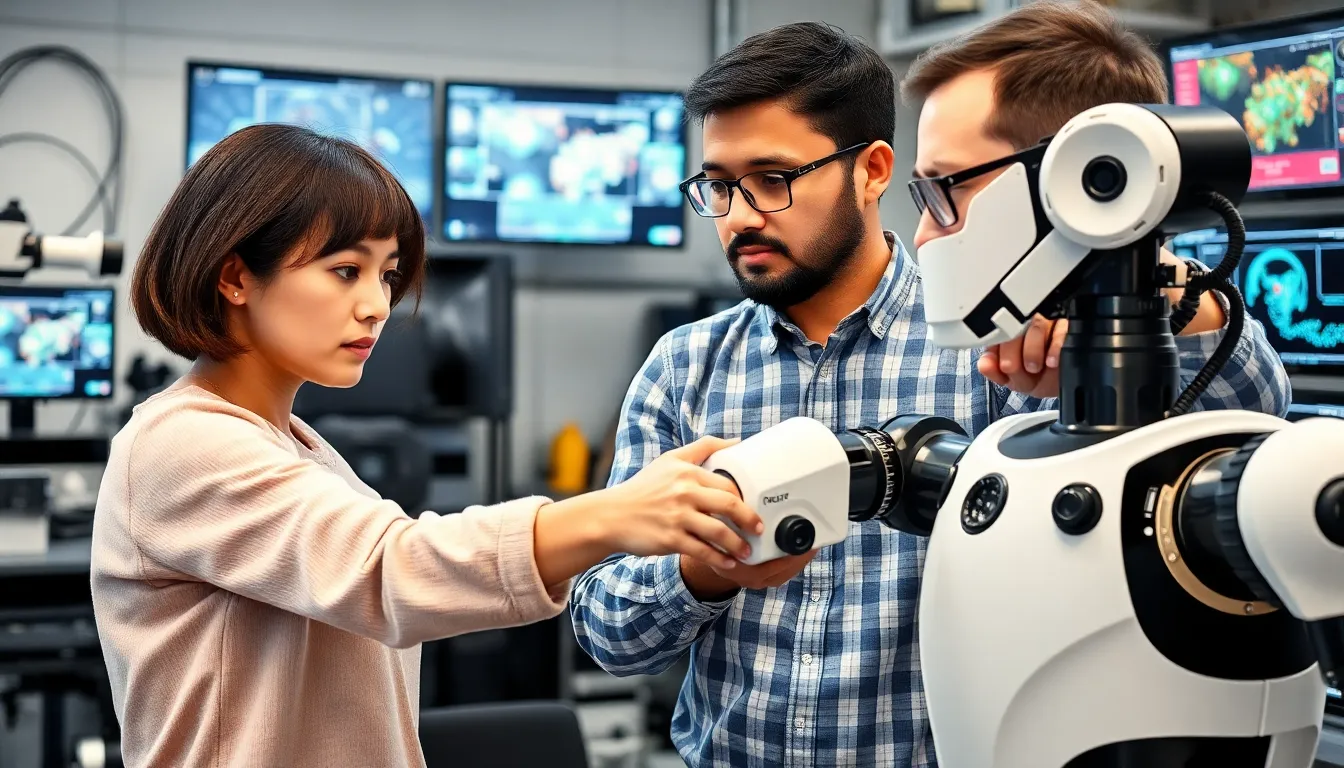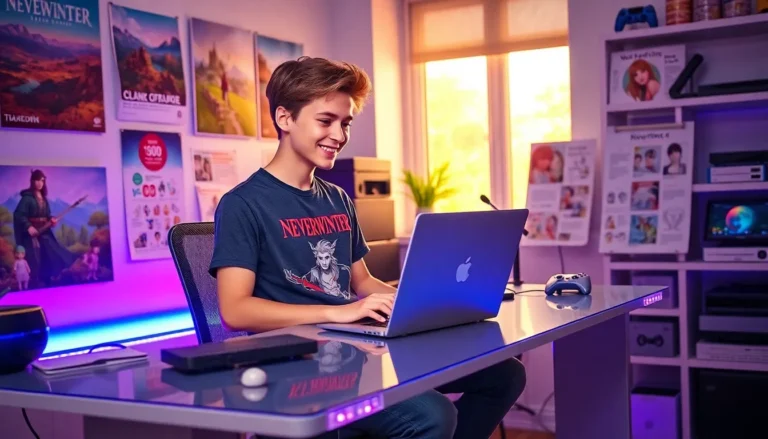In a world where robots are becoming more than just glorified vacuum cleaners, vision-based robot control is leading the charge into the future. Imagine a robot that doesn’t just obey commands but can actually see, interpret, and interact with its environment like a pro. It’s like giving your robot a pair of stylish glasses and a PhD in perception—all in one go.
This cutting-edge technology allows robots to navigate complex spaces, recognize objects, and even dodge that pesky coffee table that seems to jump out of nowhere. With vision-based control, these mechanical marvels can tackle tasks ranging from assembling products to delivering pizza (because who doesn’t want a robot delivering dinner?). Get ready to dive into the fascinating world where machines not only compute but also perceive, making them invaluable partners in our daily lives.
Table of Contents
ToggleOverview of Vision-Based Robot Control
Vision-based robot control leverages advanced technologies in computer vision and machine learning. This approach allows robots to detect and process visual information from their environment. Robots equipped with cameras perceive surroundings in real-time, facilitating accurate decision-making.
Effective navigation in complex environments relies on vision-based systems. Robots recognize obstacles, track movements, and adapt to dynamic changes. Various algorithms contribute to enhancing object recognition, enabling robots to identify items such as tools, packages, or even specific landmarks.
Assisting in diverse applications, vision-based control systems improve productivity. For instance, robots can automate assembly lines by identifying parts and assembling products with precision. In the food industry, delivery robots utilize this technology to navigate through crowds, avoiding obstacles while following designated paths.
The fusion of software and hardware strengthens capabilities in this field. Robotics researchers continuously develop algorithms that enhance visual processing capabilities. Different techniques, such as deep learning and image processing, improve accuracy in object detection.
Future advancements promise to further enhance these systems. Enhanced sensors, along with AI-driven algorithms, could allow robots to comprehend more complex scenarios. Such improvements offer the potential for robots to act more intelligently while addressing functions like emergency response or personal assistance.
Vision-based robot control plays a critical role in the evolution of robotics. Continuous innovation drives the integration of visual perception, enabling robots to operate autonomously and effectively in various environments. Each step taken in this field pushes the boundaries of what robots can accomplish in daily tasks.
Key Technologies in Vision-Based Robot Control

Vision-based robot control relies on several key technologies that enhance robots’ capabilities to interact with their environment effectively. These technologies include computer vision techniques and machine learning algorithms, which work together to improve decision-making.
Computer Vision Techniques
Computer vision techniques enable robots to process visual data from their surroundings. These methods encompass image processing, feature recognition, and object detection. Image processing involves enhancing input images for better interpretation. Feature recognition allows robots to identify specific characteristics of objects, while object detection helps in locating and classifying objects in real-time. Diverse applications benefit from these techniques, including robotics in manufacturing, agriculture, and autonomous vehicles. By accurately analyzing visual information, robots demonstrate improved navigation and interaction in complex settings.
Machine Learning Algorithms
Machine learning algorithms play a vital role in advancing vision-based robot control. These algorithms facilitate the learning process from visual data, enabling robots to adapt over time. Supervised learning, unsupervised learning, and reinforcement learning represent key approaches. Supervised learning involves training models on labeled data to make predictions, while unsupervised learning identifies patterns within unlabeled data. Reinforcement learning allows robots to learn from experience by receiving feedback based on their actions. Each approach drives continuous improvement in how robots recognize objects, navigate environments, and respond to dynamic changes.
Applications of Vision-Based Robot Control
Vision-based robot control finds extensive use across various industries, revolutionizing tasks that were once performed manually. This technology streamlines processes by enhancing efficiency, safety, and accuracy.
Industrial Automation
Industrial automation heavily relies on vision-based robot control for tasks like quality inspection and assembly. Robots equipped with advanced cameras can identify defects, ensuring only flawless products proceed along assembly lines. They also facilitate precise component placement, reducing assembly time and improving overall productivity. Smart robots learn from visual data over time, adapting their actions to enhance performance in different manufacturing settings. These capabilities significantly lower operational costs while maintaining high production standards.
Autonomous Vehicles
Autonomous vehicles utilize vision-based robot control to navigate complex environments safely. Equipped with cameras and sensors, these vehicles detect obstacles, read traffic signs, and recognize pedestrians. Real-time processing enables seamless driving decisions, enhancing safety for passengers and pedestrians alike. They rely on machine learning algorithms to improve navigation accuracy and adapt to varying conditions. The integration of vision systems becomes essential for achieving fully autonomous driving, signaling a transformative shift in transportation.
Challenges in Vision-Based Robot Control
Vision-based robot control faces several challenges that impact performance and reliability.
Environmental Factors
Lighting conditions significantly affect a robot’s ability to perceive its surroundings. Changes in ambient light can cause discrepancies in image quality, leading to misinterpretations. Furthermore, varied textures and colors within environments may hinder object recognition. Background clutter often complicates detection tasks, requiring advanced filtering mechanisms. These complexities highlight the necessity for robust algorithms that adapt in real-time, ensuring consistent performance across different scenarios.
Data Processing Limitations
Processing visual data demands considerable computational resources. High-resolution images require extensive bandwidth and quick processing capabilities. Limitations in hardware can slow down decision-making, undermining real-time responsiveness. Additionally, the sheer volume of data collected can result in delays if not managed efficiently. Overcoming these limitations involves optimizing algorithms, reducing data size without sacrificing quality, and employing specialized hardware for enhanced processing capabilities.
Future Trends in Vision-Based Robot Control
Emerging technologies are set to transform vision-based robot control significantly. Advanced deep learning models enhance object recognition capabilities, making it possible for robots to identify intricate patterns with accuracy. Increasingly, real-time data processing accelerates decision-making, allowing robots to navigate complex environments seamlessly.
Integration of artificial intelligence plays a crucial role, enabling robots to learn from visual data over time. Expanding computational power supports sophisticated algorithms that enhance visual perception under varying conditions. The use of 3D vision systems improves depth perception, enabling robots to gauge distances more accurately.
Industry applications continue to grow. In agriculture, robots equipped with vision-based systems can monitor crop health and detect pests using high-resolution imaging. Autonomous vehicles benefit from improved obstacle detection and traffic sign recognition, bolstering safety in dynamic environments.
Additionally, human-robot collaboration is gaining momentum. Vision-based robots can recognize human gestures and respond accordingly, creating more intuitive interactions. This capability is particularly valuable in healthcare settings, where robots assist medical personnel by identifying patients and managing supplies.
Addressing challenges is vital for progress. Environmental variations may hinder visual perception, necessitating adaptable algorithms to operate effectively under different conditions. Furthermore, optimizing data processing can mitigate delays caused by high-resolution image analysis, ensuring smooth robot functionality.
Continued research and development in this field promise innovative solutions that push the boundaries of vision-based robot capabilities. Integration of these trends shapes a future where robots become even more reliable and versatile assistants in various applications.
Vision-based robot control is transforming how robots interact with their environments. By integrating advanced computer vision and machine learning, these systems are becoming increasingly adept at navigating complex scenarios and performing intricate tasks. The ongoing development of algorithms and hardware will further enhance their capabilities, making them more efficient and reliable.
As industries continue to adopt this technology, the potential applications will expand, leading to innovative solutions in manufacturing, agriculture, and beyond. Addressing the challenges of environmental variability and data processing will be crucial in ensuring these robots can operate effectively. The future holds exciting possibilities for vision-based robot control, promising a new era of intelligent automation.





